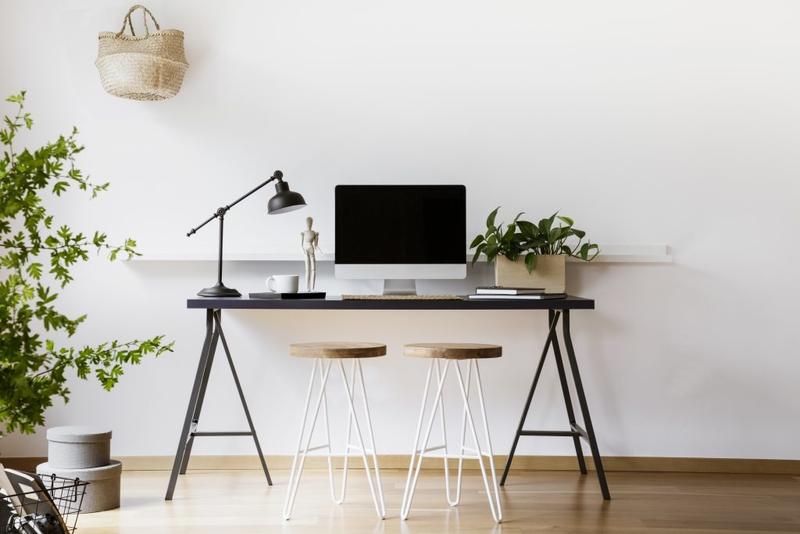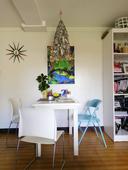The coronavirus pandemic has changed the way we think about our employment
 Foerni, a furniture leasing company in Hong Kong, rents out standing desks-one of the most popular items among its customers now working from home because of the pandemic. (PHOTO PROVIDED TO CHINA DAILY)
Foerni, a furniture leasing company in Hong Kong, rents out standing desks-one of the most popular items among its customers now working from home because of the pandemic. (PHOTO PROVIDED TO CHINA DAILY)
Susana Harding, a development worker in Singapore, bought an ergonomic chair soon after her employer imposed work-from-home arrangements to help curb the spread of COVID-19. As the director of International Longevity Center, Harding spends a lot of time sitting in front of her computer, researching and writing about issues that affect the city state's elderly population.
"I had to buy (an ergonomic) chair, one that will allow me to sit for eight hours without hurting my back unnecessarily," Harding said, citing her long medical history of back pain.
The chair complemented a table she already had in her flat. Harding also converted the guest room in her 84-square-meter apartment into a home office and has been working from there since February.
"I have the space and the equipment at home already in place, including a printer, shredder and a dedicated Wi-Fi connection. So actually, working from home is a breeze to me."
Harding is one of the thousands of professionals throughout the Asia-Pacific region who have been working from home over the past few months as governments around the region have imposed lockdowns and social distancing measures to cope with the pandemic.
"An important measure taken by governments across the world to contain the spread of COVID-19 is to encourage those who can work from home to do so," the International Labor Organization said, noting that this is one way of promoting physical distancing.
With most offices shut and even co-working spaces made unavailable, employees in Asia have had to think of ways to replicate their office spaces at home. Some, like Harding, have transformed the extra rooms in their homes into makeshift offices. But for most workers who do not have the luxury of space, the easiest and most affordable way to remain productive and efficient is to buy office desks and chairs.
Home design and furniture industry companies expect that the work-from-home trend will continue in the next few months, boosting demand for office furniture in Asia. The new demand will not come from businesses, but from private households that never had to buy this kind of furniture in the past.
"We are spending so much time at home now and (are starting to realize) the advantage of having a proper home office setup," said Pauline Wetzer, founder of Foerni, a furniture leasing company in Hong Kong.
Having launched her startup in August, Wetzer noticed early on that her most popular items are standing desks and ergonomic office chairs.
"They are popular products right now because these are the things that you don't usually have at home," she said.
Wetzer's observations may be limited to Hong Kong, but this is certainly not an isolated trend.
Several reports have shown that across the Asia-Pacific region, home-based employees have been busy buying office furniture for their homes because dining chairs and kitchen countertops are not designed for long hours of desk-bound work.
In Melbourne, Australia, swivel chairs and standing desks were in short supply in March on the back of high demand among home-bound employees, according to a report by The Age newspaper.
Sales of the Japanese furniture companies Itoki and Kokuyo rose significantly in the financial year ending March 31 on the back of home-based workers' increased demand for office desks and chairs, a report by Nikkei Asian Review said. Kokuyo's sales of office chairs alone increased by 150 percent compared with those of 2015.
 Rachelle Medina, an interior decorator, has designed her own workspace at her home in Manila. (PHOTO PROVIDED TO CHINA DAILY)
Rachelle Medina, an interior decorator, has designed her own workspace at her home in Manila. (PHOTO PROVIDED TO CHINA DAILY)
Popular items
Godrej Interio, the furniture manufacturing arm of the Indian conglomerate Godrej Group, said there has been a higher demand for work-from-home furniture amid a nationwide lockdown, according to the New Delhi newspaper the Hindustan Times. Subodh Mehta, Godrej Interio's senior vice-president, said these two items are popular among home-based workers: a work desk with a separate hutch and swivel arm that can allow more than one person to use the desk at the same time; and a chaise longe for those who want to stretch out while working on their laptops and tablets.
The London financial technology company Revolut said sales of the Singapore outlets of furniture retailers Courts and Ikea more than doubled in February and March as Singaporeans started setting up workstations at home in response to the pandemic.
Mauro Spinelli, senior expert and partner of the research and consulting firm Centre for Industrial Studies, in Milan, said the new purchases of office furniture "reflect a general dissatisfaction" among newly home-based employees who have to do their jobs in spaces not meant for work.
Spinelli said that in a global survey of home-based employees that his firm conducted, most respondents have complained about their current work chairs.
"The vast majority of respondents use a standard chair with no ergonomic properties," he said, noting that the respondents sometimes use the couch to support their backs while working. This, he said, is not an ideal solution for dealing with back problems.
While ergonomic furniture also covers other items, Spinelli said the ergonomic chair, which offers back support and helps one's posture, will remain a "pivotal" item for home-based workers.
"The purchase of a swivel chair is considered a priority now for consumers," he said. Other in-demand items include an office desk and a desk lamp.
Before the pandemic, the Asia-Pacific region was already among the fastest-growing markets for home furniture. Steady economic growth in the past few years has increased homeownership and created a bigger middle class that can splurge on new homewares.
Growing market
According to Euromonitor International, the Asia-Pacific region is the largest global market for home furnishings in terms of value and was the fastest-growing market from 2013 to 2018.
"Asia-Pacific is seeing good growth in housing stock and the number of households, benefiting sales of home furnishings," Euromonitor said in a report published in February. "Growth is further supported by rising disposable incomes. The increasingly sophisticated preferences of households and rising interest in creating comfortable and attractive homes offer good opportunities in home furnishings."
Experts said that while the pandemic may have affected demand for home furniture, it has also offered an opportunity for companies to innovate as they cope with new consumer trends.
The global measurement and data analytics company Nielsen said in its latest report that the "homebody reset" is one of the new drivers of consumption patterns. As the pandemic encourages more people to stay at home, Nielsen said, consumers are now giving priority to in-home spending over discretionary out-of-home expenses.
 (From left) Pauline Wetzer, founder of Foerni, a furniture leasing company in Hong Kong; Rachelle Medina, consultant with the Center for International Trade Expositions and Missions; Mauro Spinelli, senior expert and partner of the Centre for Industrial Studies. (PHOTO PROVIDED TO CHINA DAILY)
(From left) Pauline Wetzer, founder of Foerni, a furniture leasing company in Hong Kong; Rachelle Medina, consultant with the Center for International Trade Expositions and Missions; Mauro Spinelli, senior expert and partner of the Centre for Industrial Studies. (PHOTO PROVIDED TO CHINA DAILY)
Vaughan Ryan, Nielsen's managing director for Consumer Intelligence Asia, said the "homebody reset" in the Asia-Pacific region will also involve more online sales, given the high internet use and mobile phone ownership in the region. This is prevalent as Asians are more conscious of health and well-being, he said, given their previous experience with other public health crises such as Severe Acute Respiratory Syndrome (SARS) outbreak.
Salvio Valenzuela, executive director of the Chamber of Furniture Industries of the Philippines, said the cancellation of the annual Philippine International Furniture Show set for March may have hurt local manufacturers and exporters. But the pandemic is the time "to finally focus on innovation", he said.
Several companies are in fact responding to this shift. Godrej Interio of India has a home office collection that includes a compact study table that can fit small spaces and a high-back chair with adjustable armrests. Itoki of Japan sells desks that allow people to work while seated or standing. Koala Furniture of Australia has put onto the market a compact desk that can be folded up after the day's work is done.
"I definitely see more people investing in home office furniture, and, yes, work-from-home is the new normal," said Rachelle Medina, a consultant with the Center for International Trade Expositions and Missions, the export promotion arm of the Philippines' Department of Trade and Industry.
Children's space
Medina, an interior decorator in Manila, said she has received numerous inquiries from friends and colleagues on how to design a workspace at home. She has advised them to buy ergonomic chairs and a dedicated work table to remain productive and comfortable while working.
Working mothers like her also need to consider their children's space for studying at a time when online classes have become the norm, she said.
Daxue Consulting, a market research and management consulting firm in China, sees a rise in both home-office and children's furniture following the rise of online classes.
Even before the pandemic compelled children to study at home, demand for children's furniture had been rising in China for the past few years.
"As living standards improve, parents are increasingly willing to buy suitable furniture to create a good environment for their children's development," the Hong Kong Trade Development Council said in a report in August.
The pandemic is expected to boost this demand. Hu Yuwan, chief operating officer of Daxue, said she expects more Chinese customers to buy home office furniture that can be used by both adults and children.
"Children's education is one of the priorities of Chinese families," she said, noting that a middle-class family allocates more than 30 percent of its monthly income to children's education.
This is why it is important for furniture makers and retailers also to consider the needs and interests of children when marketing home-office furniture, Hu said.
Asian governments have been easing lockdowns and movement restrictions in the past few weeks. With offices reopening, some home-based employees are going back to work.
But experts say the pandemic has changed the working environment. While they do not see all employees working entirely from home, they expect companies to implement partial work-from-home arrangements under the new normal.
Spinelli of the Centre for Industrial Studies said that even before the COVID-19 outbreak pushed most employees to work at home, telecommuting had been on the rise for the past decade because technology had allowed more people to work remotely.


